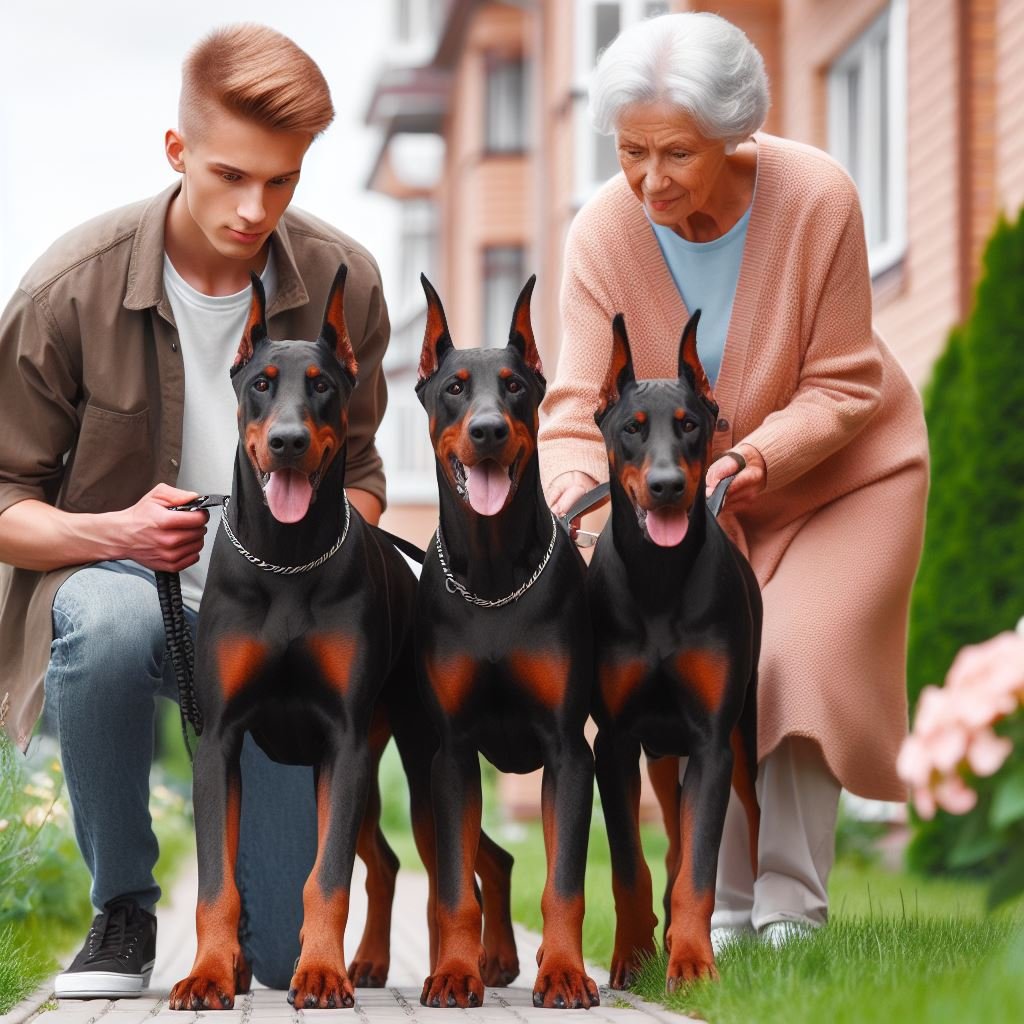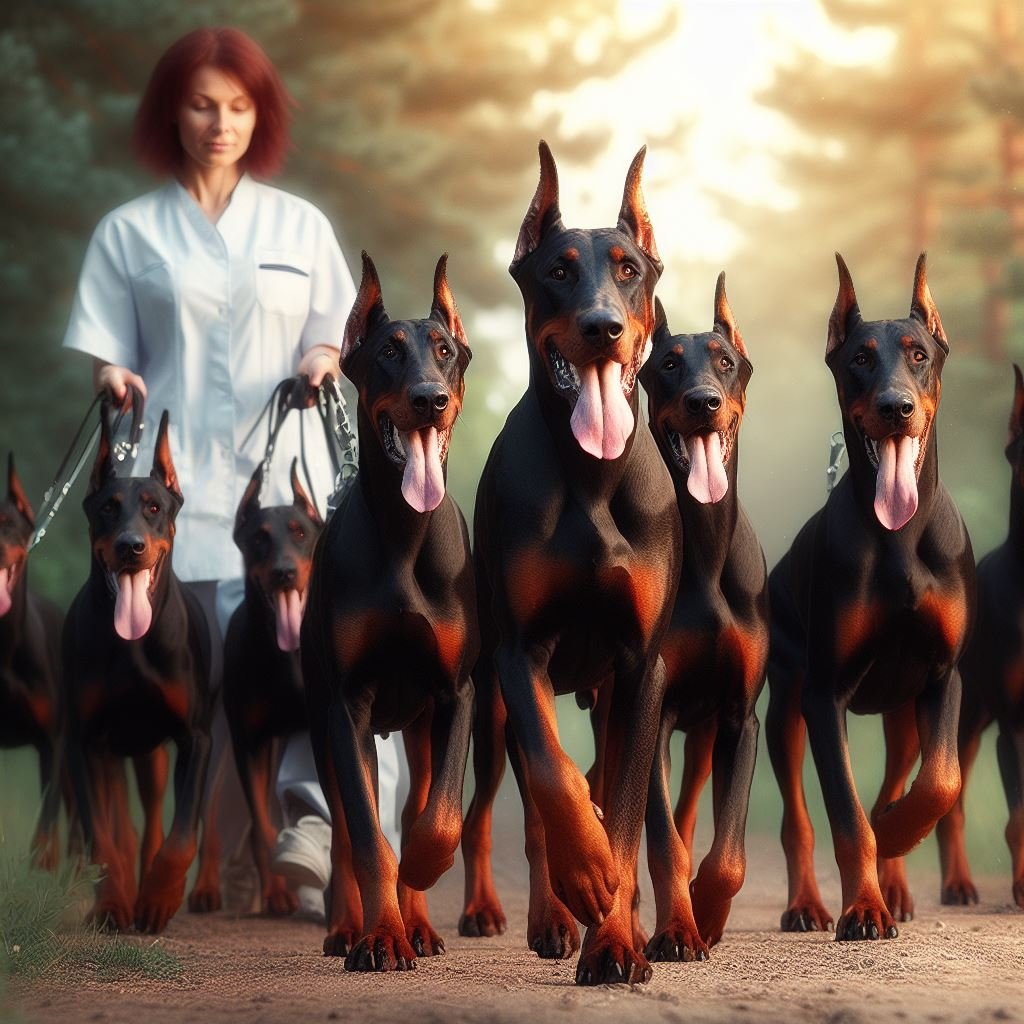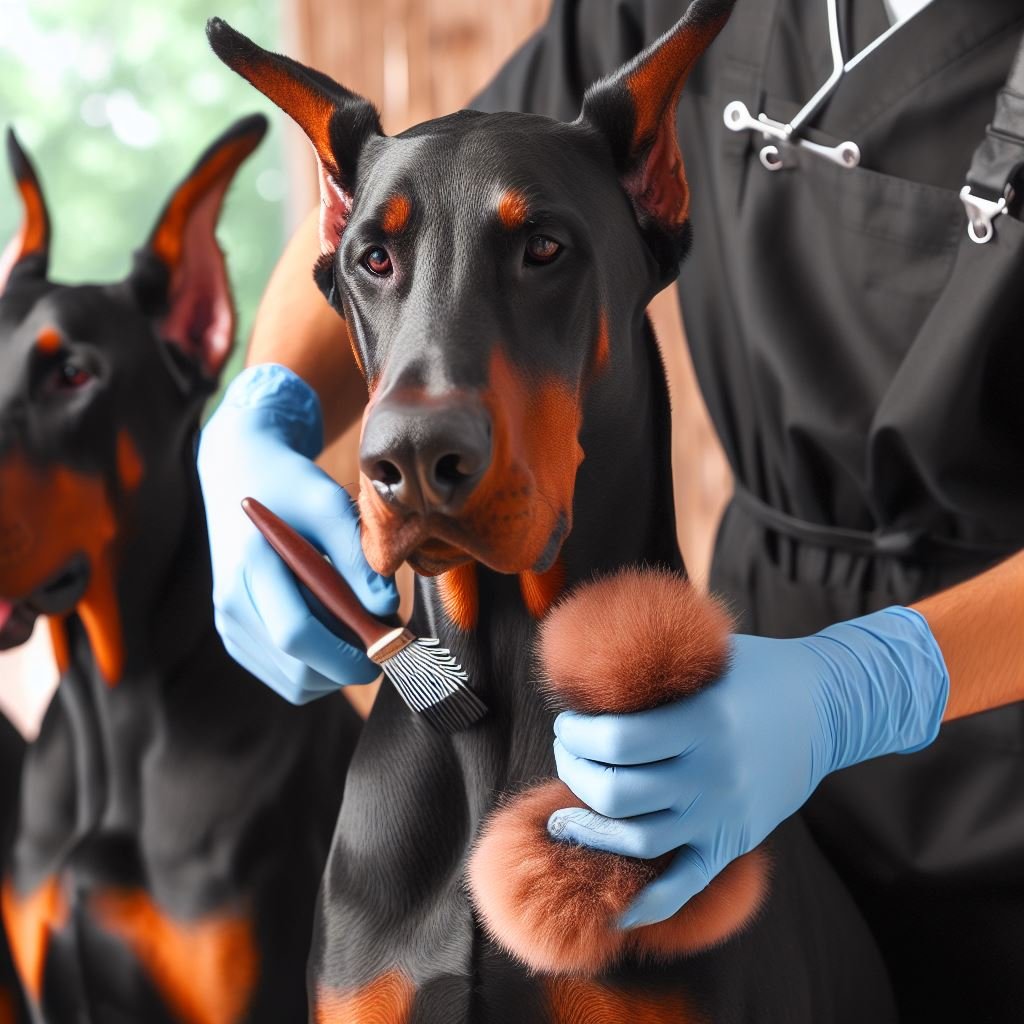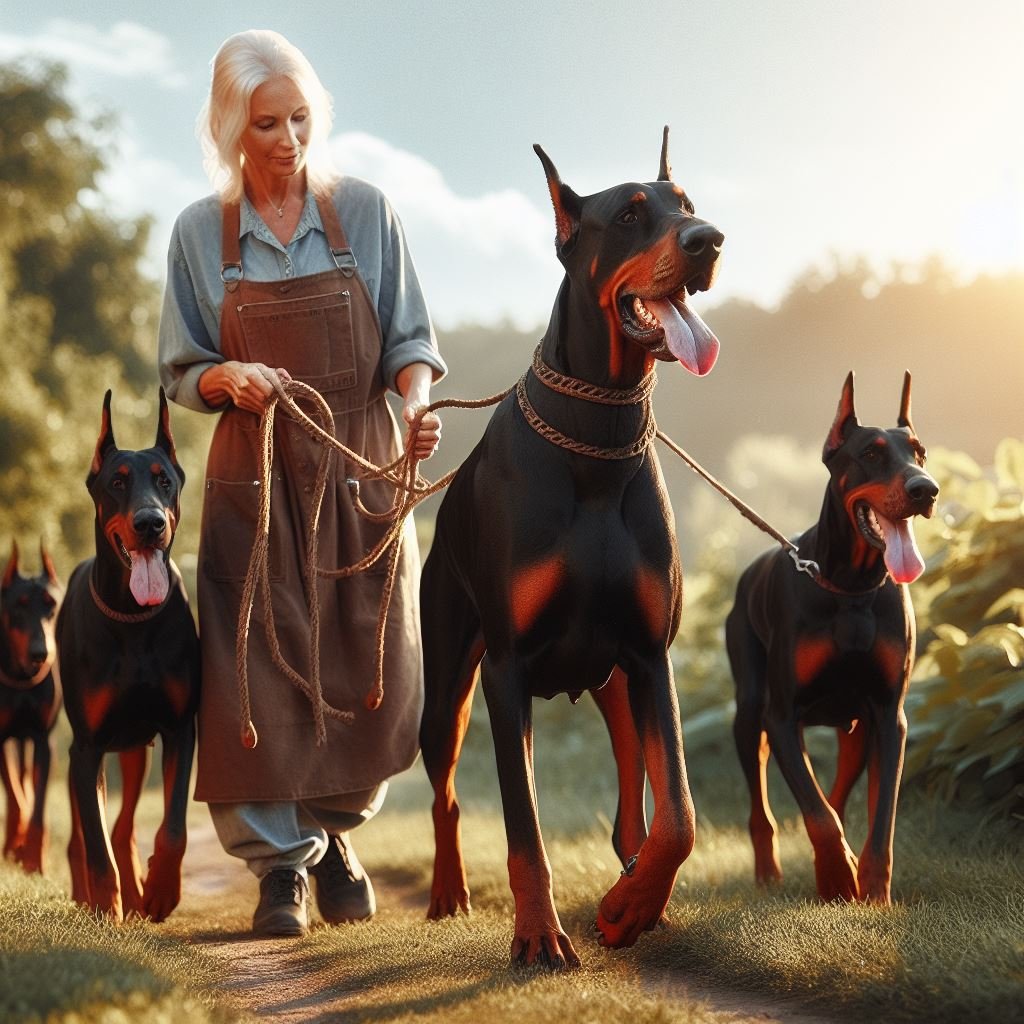Breeding Dobermans is a fascinating and rewarding endeavor for dog lovers. Dobermans are known for their intelligence, loyalty, and protective nature, making them excellent family pets and working dogs. If you are considering breeding Dobermans, it is essential to understand the responsibilities and considerations involved in the process.
Basic Information
Here’s a concise overview of essential facts about Dobermans:
| Aspect | Details |
|---|---|
| Traditional Colors | Common coat colors include black, red, blue, and fawn. Some have tan markings. |
| Weight | Adult Dobermans typically weigh between 60 to 100 pounds. |
| Size | They are medium to large dogs, standing around 24 to 28 inches at the shoulder. |
| Dog Height | Their height ranges from 24 to 28 inches (measured at the shoulder). |
| Lifespan | On average, Dobermans live 10 to 13 years. |
| Price | Prices vary based on lineage, quality, and purpose (working vs. pet). |
| Suitable For | Dobermans are excellent guard dogs, loyal companions, and versatile working dogs. |
Physical Appearance
Dobermans exhibit a striking appearance with distinct features:
| Feature | Description |
|---|---|
| Facial Structure | Their faces are sleek and alert, with a strong jawline. |
| Coat | Short, dense, and glossy coat that lies close to the body. |
| Nose | Black or dark brown, matching the coat color. |
| Eyes | Almond-shaped, medium-sized, and usually dark brown. |
| Ears | Cropped or natural (uncropped), standing erect. |
| Muzzle | Powerful and well-defined, tapering slightly towards the nose. |
| Body | Muscular, athletic, and balanced, with a deep chest and strong back. |
Quick Facts
Here are some essential quick facts about Dobermans:
| Aspect | Details |
|---|---|
| Temperament | Intelligent, loyal, protective, and alert. |
| Reproduction | Dobermans have straightforward pregnancies and generally do well without human assistance. |
| Playtime | They enjoy active play and mental stimulation. |
| Intelligence | Highly intelligent and responsive to training. |
| Evolutionary Origins | Bred by Karl Friedrich Louis Doberman in Germany for loyalty and protection. |
| Genetics | Combines traits from several breeds. |
| Breed Group | Belongs to the Working Group. |
Games

Breeding Dobermans playing with child
Dobermans thrive on physical and mental activity. Here are some games they enjoy:
Indoor Games
- Hide and Seek: Hide treats or toys around the house for them to find.
- Puzzle Toys: Use interactive toys that challenge their minds.
- Fetch: Play fetch indoors using soft toys or balls.
Outdoor Games
- Agility Courses: Set up obstacle courses for them to navigate.
- Swimming: Dobermans often enjoy water activities.
- Chase and Retrieve: Play fetch in the yard or park.
Special Key Points
Consider these unique aspects of Dobermans:
| Aspect | Details |
|---|---|
| Adaptability | They adapt well to various living environments. |
| Senses | Excellent vision, hearing, and sense of touch. |
| Sleep Patterns | They need sufficient rest to maintain their energy levels. |
| Sense of Smell | Not as strong as some other breeds, but still effective. |
| Loyalty | Dobermans form strong bonds with their chosen person or family. |

Breeding Dobermans Dog
Choosing Healthy Parent Dogs
The first step in breeding Dobermans is selecting healthy parent dogs. Both the male and female should undergo thorough health screenings to ensure they are free from genetic disorders and other health issues. It is crucial to choose dogs with excellent temperaments, sound structure, and desirable breed characteristics. Working with a reputable breeder or consulting with a veterinarian can help you find suitable parent dogs.

Breeding Dobermans Dog Choosing Healthy Parent Dogs
Understanding the Breeding Process
Dobermans typically reach sexual maturity between six months and one year of age. Breeding should only take place when both dogs are physically and mentally mature. The female dog will come into heat approximately twice a year, during which she is receptive to mating. It is essential to carefully plan the breeding to ensure the health and well-being of both the female and the puppies.
Mating and Pregnancy
When the female Doberman is in heat, she will exhibit certain behaviors and physical signs. These signs include a swollen vulva, a bloody discharge, and increased urination. It is important to introduce the male and female in a controlled environment to prevent any aggressive behavior. Once mating occurs, the female will typically remain pregnant for around 63 days.
During the pregnancy, the female Doberman will require extra care and attention. It is crucial to provide her with a balanced diet and ensure she gets regular exercise. Regular veterinary check-ups are also important to monitor the health of the mother and the developing puppies.
Whelping and Raising Puppies
As the due date approaches, it is important to prepare a comfortable and safe whelping area for the mother and puppies. The whelping area should be warm, clean, and free from any potential hazards. The mother will typically give birth to a litter of puppies, which will require round-the-clock care and attention.
During the first few weeks, the puppies will rely on their mother for nourishment. It is important to provide the mother with a high-quality diet to ensure she produces enough milk for the puppies. As the puppies grow, they will start to explore their surroundings and develop their individual personalities.
Socialization is a crucial aspect of raising Doberman puppies. Exposing them to different people, animals, and environments from an early age will help them become well-rounded and confident adults. It is also important to start basic training and obedience exercises to establish good behavior and manners.
Placing Puppies in Suitable Homes
As the puppies grow and develop, it is important to find suitable homes for them. Responsible breeders take the time to screen potential owners and ensure they can provide a loving and suitable environment for a Doberman. It is important to educate new owners about the breed’s characteristics and requirements to ensure a successful and lifelong partnership.
Additionally, responsible breeders may require new owners to sign a contract that includes spaying or neutering the puppy, as well as providing regular veterinary care and a safe living environment.

Breeding Dobermans healthy dog walking in the forest
Health and Caring
Breeding Dobermans involves a commitment to their health and well-being. Here are essential aspects to consider:
Health Issues
Dobermans are prone to certain health conditions, including:
- Dilated Cardiomyopathy (DCM): A heart disease common in large breeds.
- Hip Dysplasia: A joint disorder affecting mobility.
- Von Willebrand’s Disease: A bleeding disorder.
- Hypothyroidism: An underactive thyroid gland.
- Regular veterinary check-ups and preventive care are crucial.
Read More: Common Health Issues in Dogs
Dog Food and Diet Requirements
- Feed high-quality dog food suitable for their age and activity level.
- Consider a balanced diet with protein, healthy fats, and essential nutrients.
- Avoid overfeeding to prevent obesity.
Grooming

Breeding Dobermans dog are taking grooming
- Dobermans have short coats that require minimal grooming.
- Brush them weekly to remove loose hair.
- Regular nail trimming and dental care are essential.
Read More: The Art of Dog Grooming
Training
- Early socialization is vital for well-adjusted Dobermans.
- Positive reinforcement training works best.
- Teach basic commands and leash manners.
Exercise
- Dobermans are energetic and need regular exercise.
- Daily walks, playtime, and mental stimulation are essential.
- Consider agility training or other activities.
Socialization
- Introduce them to various people, animals, and environments.
- Proper socialization prevents fear or aggression.
Read More: The Importance of Dog socialization
Communication
- Dobermans are attentive and responsive.
- Use clear commands and consistent communication.
Caretaker

Breeding Dobermans dog are walking with caretaker
- Responsible breeders provide a safe and loving environment.
- Regular exercise, mental stimulation, and companionship are crucial.
Recognizing Dobermans
- Look for their sleek, muscular build and short coat.
- Notice their alert expression and cropped or natural ears.
- Their distinctive black, red, blue, or fawn coat colors stand out.
Male vs. Female
- Both genders make excellent companions.
- Males are generally larger and more protective.
- Females may be more independent but equally loyal.
Helpful YouTube Link: Doberman Pinscher Puppies – Breeding Dobies – YouTube
Conclusion
Breeding Dobermans can be a fulfilling experience for dog lovers who are committed to the well-being of the breed. It is important to approach breeding with careful consideration, ensuring the health and welfare of the parent dogs and the puppies. By selecting healthy parent dogs, understanding the breeding process, and providing proper care and socialization, you can contribute to the preservation and improvement of this remarkable breed.
Breeding Dobermans: Frequently Asked Questions
Is there a difference between male and female Dobermans?
Both genders make excellent companions.
Males are generally larger and more protective.
Females may be more independent but equally loyal.
What are some indoor and outdoor games for Dobermans?
Indoor Games: Hide and seek, puzzle toys, and fetch.
Outdoor Games: Agility courses, swimming, and chase and retrieve.
How do I care for pregnant Dobermans?
Doberman pregnancies generally go well without human assistance. Provide proper nutrition, exercise, and a comfortable environment for the expecting mother.
What health concerns should I consider when breeding Dobermans?
Dobermans are prone to conditions like Dilated Cardiomyopathy (DCM), hip dysplasia, and Von Willebrand’s Disease. Regular veterinary check-ups and preventive care are essential.
What is the background of Doberman breeding?
The Doberman Pinscher was created by Karl Friedrich Louis Doberman in Germany. He combined several breeds to develop a loyal, devoted, and protective dog. Despite misconceptions, Dobermans can be excellent family dogs when well-socialized and trained.
How do I start breeding Dobermans?
Breeding Dobermans involves understanding their lineage, training, and socialization. Decide whether you want to breed working dogs (guard dogs) or family pets. Both options have their merits, so choose based on your preferences and budget.


 Mini Labradoodle: A Complete Guide
Mini Labradoodle: A Complete Guide  Dapple Dachshund: A Unique and Lively Breed
Dapple Dachshund: A Unique and Lively Breed  Pocket Pitbull: A Compact Canine Companion
Pocket Pitbull: A Compact Canine Companion  Preparing for an Adventure: A Golden Retriever Packs Its Suitcase
Preparing for an Adventure: A Golden Retriever Packs Its Suitcase  The Blue Merle Australian Shepherd: A Captivating and Unique Breed
The Blue Merle Australian Shepherd: A Captivating and Unique Breed  Long Haired Dachshund: A Guide to This Charming Breed
Long Haired Dachshund: A Guide to This Charming Breed